Hooded Merganser numbers in the Wetlands have fluctuated between 4 and 11 birds. The males can sometimes be seen bobbing their heads, rearing up in the water and, with their bills pointed skyward, emitting a low-pitched snore-like staccato. They’re vying for the attention of the females. It often seems that all of the males are perusing one female, who, by the way, appears little impressed with all of their strutting and showing off.
Cooper’s Hawks and, since the second week in September, Red-tailed Hawks have been seen consistently. Some are locals and some are migrating through – I’ve seen adults and immatures of both species. An adult Sharp-shinned Hawk was seen 29 November.
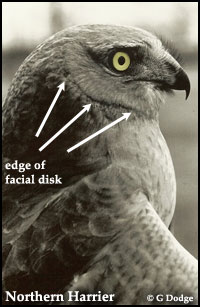 A true sign of winter’s arrival, or at least it being at the doorstep, was the appearance overhead of an adult male Northern Harrier in the clear blue sky of 26 November. The nearly all gray adult males are the last in line to migrant through, following the brown-hued immature and female harriers. It was the first of its kind that I’d seen at the Museum.
A true sign of winter’s arrival, or at least it being at the doorstep, was the appearance overhead of an adult male Northern Harrier in the clear blue sky of 26 November. The nearly all gray adult males are the last in line to migrant through, following the brown-hued immature and female harriers. It was the first of its kind that I’d seen at the Museum.
Harriers are birds of open country – extensive farmlands and coastal marshes are more likely places to see them. There, they cruise low over the vegetation watching and listening for small mammals and birds to prey upon. Harriers have an owl-like facial disk (B&W image at left) which aids in picking up faint sounds coming from potential prey below them as the hawks sail and hover a few feet above the fields and marshes. It’s not likely you’ll see a Northern Harrier at the Museum except in passing, so keep at least one eye skyward, especially after a few days of northerly winds!
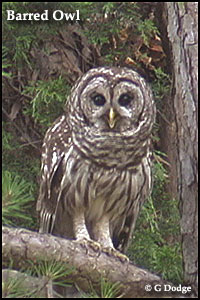 Crows are well know for harassing hawks and owls whenever they can. So, it’s no surprise that on November 29, a small group of crows (about 5) couldn’t resist ganging up on a Barred Owl when they spotted it perched in a Loblolly Pine in the swamp just below the entrance to Catch the Wind on the back side of the Explore the Wild/Catch the Wind Loop. The owl, after several minutes of cawing and badgering by the crows, was rousted from its perch and took off flying with the crows in hot pursuit – much to the amazement, and delight, of Ornithopter Operator John as the owl flew within ten feet of his head.
Crows are well know for harassing hawks and owls whenever they can. So, it’s no surprise that on November 29, a small group of crows (about 5) couldn’t resist ganging up on a Barred Owl when they spotted it perched in a Loblolly Pine in the swamp just below the entrance to Catch the Wind on the back side of the Explore the Wild/Catch the Wind Loop. The owl, after several minutes of cawing and badgering by the crows, was rousted from its perch and took off flying with the crows in hot pursuit – much to the amazement, and delight, of Ornithopter Operator John as the owl flew within ten feet of his head.
A pair of these dark-eyed owls were spotted earlier in the period by two of the Museum’s Animal Keepers near the main entrance to Catch the Wind. Keep an eye out for these birds as you stroll along the Explore the Wild/Catch the Wind Loop!
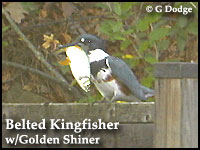 The resident female Belted Kingfisher has been spending considerable time at the Wetlands. Even when she can’t be seen splashing and diving in the water for fish, her raspy rattle of a call can usually be heard somewhere back among the trees on the far side of the Wetlands.
The resident female Belted Kingfisher has been spending considerable time at the Wetlands. Even when she can’t be seen splashing and diving in the water for fish, her raspy rattle of a call can usually be heard somewhere back among the trees on the far side of the Wetlands.
While standing on the Wetlands Overlook video taping the local Great Blue Heron gently preening its long blue-gray primaries, I heard a splash in the water to my right. As I turned to see what had made the noise, the kingfisher was already up and flying towards the boardwalk in front of the Black Bear Exhibit. It had something large in its bill. A kingfisher is not a small bird, a little over a foot from end to end. As the bird landed on the railing of the boardwalk I could see that it had a sizable Golden Shiner in its bill (image at left). The fish was easily half, or more, the length of the bird.
After several unsuccessful attempts to flip the fish head first so that it could swallow it, the kingfisher flew off to the far side of the Wetlands to perch on a low willow branch. Through the eyepiece of the video camera I could see the bird again and again try to turn the fish around, all the while the fish struggling to get free of the bird’s grip. Finally, the bird lost its hold on the shiner and it fell to the water below, the bird crashing in behind. When the bird flew back up to its perch, only scales remained in its long dark bill. Apparently, the fish was not mortally wounded by this encounter. I’m not sure whether the bird could have swallowed such a large fish had it been able to hold on to it, but it would have been fun to watch it try.
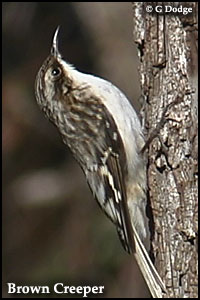 There was a flurry of bird activity with the approach of a low pressure system on the last Saturday of November. Birds often feed heavily ahead of impending inclement weather. Among the birds seen was a Brown Creeper (photo at right), the first I’d seen at the Museum since last January. These small, secretive, brownish birds creep up tree trunks gleaning small invertebrates along the way. Their presence is often given away as they fly from a high point on one tree to the base of another to start a new ascent.
There was a flurry of bird activity with the approach of a low pressure system on the last Saturday of November. Birds often feed heavily ahead of impending inclement weather. Among the birds seen was a Brown Creeper (photo at right), the first I’d seen at the Museum since last January. These small, secretive, brownish birds creep up tree trunks gleaning small invertebrates along the way. Their presence is often given away as they fly from a high point on one tree to the base of another to start a new ascent.
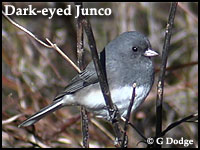 Also seen feasting that day were Brown-headed Nuthatches, Hermit Thrush, Ruby-crowned Kinglet, several sparrows including Chipping Sparrow, White-throated Sparrow, and Dark-eyed Junco (image here), Pine Warbler, and a lone Common Yellowthroat. With the cooler weather and the lack of flying insects to hawk, the Myrtle (Yellow-rumped) Warblers have been feasting on Wax Myrtle berries.
Also seen feasting that day were Brown-headed Nuthatches, Hermit Thrush, Ruby-crowned Kinglet, several sparrows including Chipping Sparrow, White-throated Sparrow, and Dark-eyed Junco (image here), Pine Warbler, and a lone Common Yellowthroat. With the cooler weather and the lack of flying insects to hawk, the Myrtle (Yellow-rumped) Warblers have been feasting on Wax Myrtle berries.
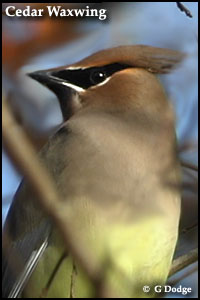 A wandering of Cedar Waxwings sailed over the Wetlands on 20 November. You don’t often see waxwings alone; this group consisted of about twenty-five individuals. Unless there’s a reason to stop, like a good supply of berries or crab apples to eat, these traveling bands of birds are usually seen flying overhead in search of the same.
A wandering of Cedar Waxwings sailed over the Wetlands on 20 November. You don’t often see waxwings alone; this group consisted of about twenty-five individuals. Unless there’s a reason to stop, like a good supply of berries or crab apples to eat, these traveling bands of birds are usually seen flying overhead in search of the same.
The in-flight flocks look a bit like starlings as they wheel and whirl about. Although noticeably lighter in color, in outline the individual birds appear starling-like as well. However, that’s where the similarity ends. Cedar Waxwings are one of the most elegant of birds (image at left). Their soft fawn-beige plumage fading to yellow on the belly, their yellow-tipped tail (sometimes orange), black facial mask, and crest make it hard not to find them attractive. They appear to never have a feather out of place, always neat and trim. The name waxwing comes from the small, red, wax-like spots on their wings (not shown).
Closing Shot
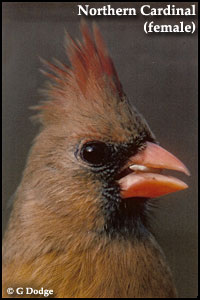 As anyone with a bird feeder in their backyard can tell you, Northern Cardinals are usually the first to arrive and the last to leave the party. The photo at left shows a female grabbing one last meal of sunflower seeds from the feeders in Catch the Wind before calling it a night.
As anyone with a bird feeder in their backyard can tell you, Northern Cardinals are usually the first to arrive and the last to leave the party. The photo at left shows a female grabbing one last meal of sunflower seeds from the feeders in Catch the Wind before calling it a night.